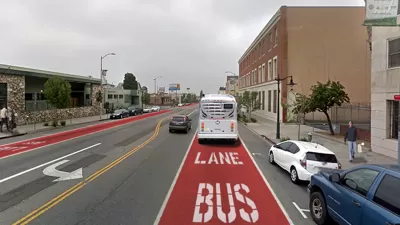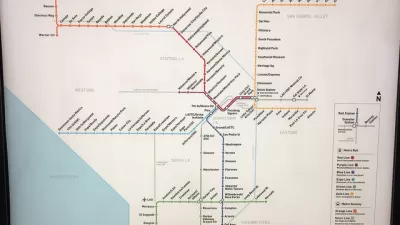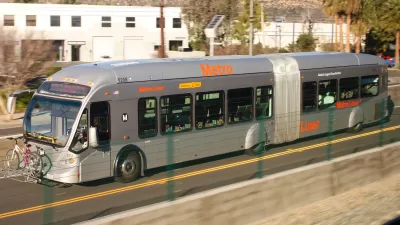Anyone hoping for rail transit down one of Los Angeles' busiest transit corridors will have to wait awhile.

When Los Angeles voters approved Measure M in 2016, they provided some funding for a planned bus rapid transit (BRT) route down 12.4 miles of the very busy Vermont Avenue corridor. That project is scheduled to begin in 2024 and open by 2028, if complete funding construction is acquired before then.
Now, however, the Los Angeles County Metropolitan Transportation Authority (Metro) is making plans to turn that BRT project into a light rail route in the very distant future.
"A report to be given this week to the Metro Board's Planning and Programming sheds light on how an as-of-yet unbuilt bus rapid transit line on Vermont Avenue could be converted into a rail line in the distant year of 2067," reports Steven Sharp.
The report studies rail transit as an option and comes up with three options, explains Sharp:
- Center-running light rail transit - similar to the Blue Line - with below-grade between operations between Wilshire/Vermont Station in Koreatown and Gage Avenue, where trains would proceed to an at-grade alignment within a wide center median to 120th Street;
- An extension of the Red Line starting at the corner of Vermont and 3rd Street, continuing south in a fully below-grade alignment to 120th Street; and
- A standalone heavy rail line starting at Wilshire/Vermont Station and proceeding below-grade to 120th Street.
In current construction costs, these projects would require between $4.4 billion on the cheap end and $8.4 billion on the expensive end. In 2067 costs, that would be $21.1 billion and $34.7 billion.
The largest impediment to any new transit on Vermont Avenue is funding, according to Sharp. Even the BRT project only has $25 million in funding from the Measure M total.
For insight into the importance of Vermont Avenue in the Los Angeles regional transit system, see an opinion written by Alon Levy in early 2018.
FULL STORY: Study Explores How Metro Could Convert the Proposed Vermont BRT Line to Rail

Planetizen Federal Action Tracker
A weekly monitor of how Trump’s orders and actions are impacting planners and planning in America.

Restaurant Patios Were a Pandemic Win — Why Were They so Hard to Keep?
Social distancing requirements and changes in travel patterns prompted cities to pilot new uses for street and sidewalk space. Then it got complicated.

Map: Where Senate Republicans Want to Sell Your Public Lands
For public land advocates, the Senate Republicans’ proposal to sell millions of acres of public land in the West is “the biggest fight of their careers.”

Maui's Vacation Rental Debate Turns Ugly
Verbal attacks, misinformation campaigns and fistfights plague a high-stakes debate to convert thousands of vacation rentals into long-term housing.

San Francisco Suspends Traffic Calming Amidst Record Deaths
Citing “a challenging fiscal landscape,” the city will cease the program on the heels of 42 traffic deaths, including 24 pedestrians.

California Homeless Arrests, Citations Spike After Ruling
An investigation reveals that anti-homeless actions increased up to 500% after Grants Pass v. Johnson — even in cities claiming no policy change.
Urban Design for Planners 1: Software Tools
This six-course series explores essential urban design concepts using open source software and equips planners with the tools they need to participate fully in the urban design process.
Planning for Universal Design
Learn the tools for implementing Universal Design in planning regulations.
Heyer Gruel & Associates PA
JM Goldson LLC
Custer County Colorado
City of Camden Redevelopment Agency
City of Astoria
Transportation Research & Education Center (TREC) at Portland State University
Camden Redevelopment Agency
City of Claremont
Municipality of Princeton (NJ)





























